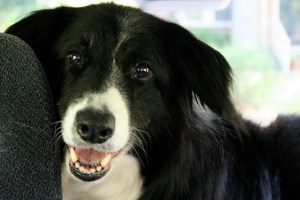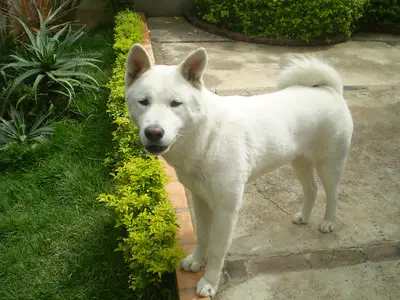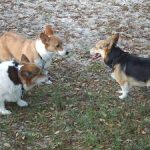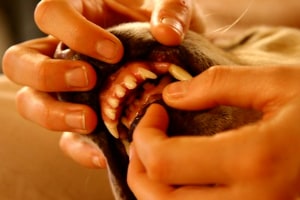
Have you ever seen a dog who seems to be baring his teeth at you, only to discover that, no, the poor guy is not being aggressive in any way?
That crooked smile is part of who he is. This is something you’ll find in a dog with an overbite. These dogs might look a bit odd, although overbites, more or less visible, are quite common in many types of dog.
A lot of pet owners wonder whether they should do something to correct this ‘problem’. This article will explain all you need to know about overbites, what causes them and what are your options. And, we’ll also have a look at various breeds prone to overbites.
What is an overbite?
A dog’s teeth may be misaligned for various reasons, the most common being an overbite.
An overbite is when the maxilla is longer than the mandible. As a result, when the dog closes his mouth the upper teeth will be in front of the lower one, instead of being at the same level. This condition is often referred to as an overshot jaw, overjet, parrot mouth, while a professional will probably confuse you by calling it a Class 2 malocclusion.
How is it caused?
An overbite has genetic causes, it’s an inherited condition. Even if the parents have perfectly aligned teeth, their offspring might still exhibit an overbite, as this condition can very well skip a generation or two.
Overbites are more common in breeds with a long narrow snout, such as Dachshunds, Border Collies or German Shepherds. (More on that later.)
On the other hand, brachycephalic breeds, like Bulldogs, Pugs or Boston Terriers often present an underbite, where the lower jaw is longer than the upper one and the dog’s lower teeth stick out a bit.
What are some of the consequences of an overbite?
Experts say an overbite can have serious consequences for a dog.
One of the main problems is the lower teeth might press into the dog’s palate, making eating quite painful. Of course, this happens if and when the lower teeth grow too big. The lower teeth rubbing into the palate can cause oral irritation, blistering and even bleeding in extreme cases.
Overbites may also contribute to the apparition of gum disease, although this might have other causes as well. Gum disease is an oral inflammation which can weaken the teeth and cause them to become loose or fall out altogether.
If the teeth are misaligned they tend to grind against each other, which can lead to excessive wear and tear of some of the teeth involved.
Finally, an overbite (or an underbite) can cause eating problems as the longer jaw might make grabbing food more difficult. However, a dog born this way will probably develop his own eating technique to bypass such problems.
How can it be treated?
First of all, you need to establish if the dog does need treatment for the overbite.
Virtually all experts say aesthetic reasons do not warrant subjecting an animal to painful tooth extractions, oral surgery or braces. Plenty of humans put themselves through the misery of wearing braces for years, but it’s their own decision.
However, if you notice your pup has a slight overbite, it is recommended to see a specialist early on, preferably when the dog is 6 – 9 weeks old. A canine dental expert might recommend the extraction of some of the dog’s baby teeth, in the hope that this will allow the lower jaw to grow.
Now, this treatment method might or might not help a dog, especially as it is a genetic condition. On the other hand, in many cases, the overbite problem resolves itself naturally as the dog matures.
The specialist will reexamine the dog’s mouth once permanent teeth appear and, if the problems persist, he might suggest removing some of the adult teeth as well.
Other treatment methods involve the amputation of the crown of the offending tooth, which is exactly as horrible as it sounds, as it means cutting the upper part of the tooth, above the gum.
One of newer options experts recommend is braces or other orthodontic implements to correct the overbite. The dog might have to wear braces for a few months… or years.
All these treatment methods will cause the poor dog a lot of suffering, but you’ll suffer too, since you can well imagine these dental procedures do not come cheap.
Extractions cost anywhere between $150 and $1,500 per tooth. Crown amputations are more complex procedures, so the price tag is $1,500 to $3,000, per tooth. As for braces, you’re looking at something around $4,000, plus the regular visits to the doggie dentist.
7 dog breeds with overbite
[1] Border Collies
Border collies are among the most popular pets in the world because they’re very affectionate and intelligent, as well as easy to train.
Also,they’re medium sized dogs, growing up to 18-22 inches, so they can easily fit in an apartment, although they do prefer big yards where they can consume their vast amount of energy.
Border collies have a long narrow snout, which makes them prone to overbite. This does not stop from eating, though, and an adult collie will need around 1.5 to 2 cups of dry food per day.
To prevent gum disease, it is recommended that you brush your dog’s teeth two or three times a week.
Shelties
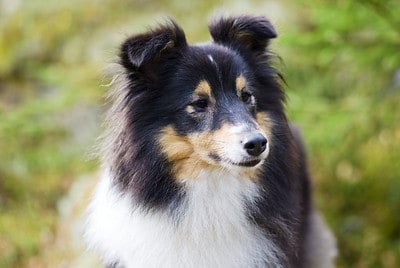
The Shetland Sheepdog, popularly known as a Sheltie, belongs to the herding dogs group and it’s known for its remarkable intelligence.
It ranked 6th out of 138 breeds tested in one experiment conducted in the 1990s. Shelties are on the small side, reaching only 13 – 16 inches at maturity.
They’re easily recognizable with their long coats, which come in regular colors such as sable, black, white and tan, or in the spectacular (and genetically modified) blue merle.
They make excellent pets and they’re quite eager to please, but keep in mind they tend to bark a lot. Early training is required to teach them to keep it down.
Dachshunds
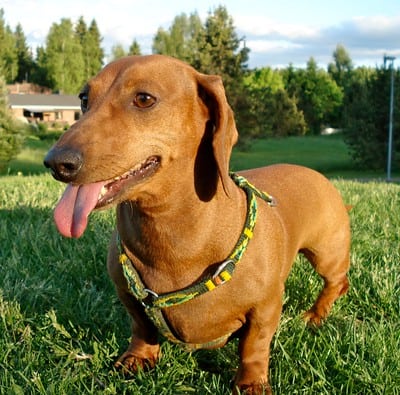
Dachshunds were specifically bred to have long snouts as they were used as badger dogs and were required to poke their nose in underground dens and scare the occupants away.
Now that they live as pets, they might use their long snouts to raid the table or the trash can in search of food. They tend to overeat and they can pile up some extra pounds if you don’t teach them not to steal food.
Standard Dachshunds grow up to 9 inches tall, while the miniature version barely reaches 6 inches. Both versions are equally energetic and will require at least two (long) walks per day.
German Shepherds
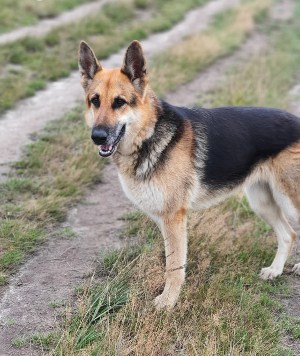
Many people decide to get themselves a German Shepherd because such a large dog is an impressive bodyguard, but at the same time it’s a very affectionate dog.
An adult can reach up to a massive 2 feet in height, yet German Shepherds are quite gentle, even with children.
This gentle giant does not tolerate being alone, and if his owners are away for many hours a day, the dog might use that long snout of his to chew anything in sight, overbite or no overbite.
If you want to keep your shoes safe, better give your German Shepherd a large bone to chew.
This will keep him busy for a while and chewing helps cleaning his teeth, preventing gum disease and bad breath.
Russian wolfhounds
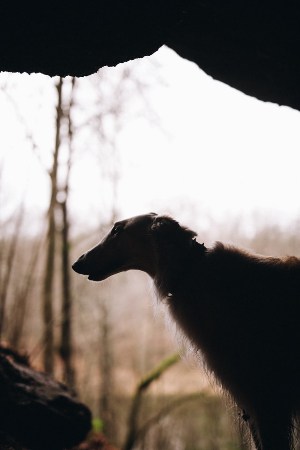
Also known as Borzoi, Russian wolfhounds were bred as hunting dogs. They’re extremely agile and fast, and having long lean feet is a big plus for a hunting dog.
Adult males can weigh up to 75 – 100 pounds, and it’s mostly muscle. Contrary to popular belief, Russian wolfhounds cannot kill a wolf and were never used for this purpose.
They can be aggressive towards other dogs.
They can be taught to like children, if they grow up with them, but training is a bit difficult as Russian wolfhounds are a bit stubborn.
Greyhounds
Greyhounds don’t just have long narrow snouts, their whole body is like that. This lean narrow body is extremely aerodynamic, which sort of explains why greyhounds are the fastest dogs in the world.
They can reach speeds of up to 70kmh, so yes, they will need good obedience training if you don’t want to have problems when you take them out for a walk.
Greyhounds are quite affectionate towards their owners, but have little patience for small kids.
Whippets
Whippets are medium-sized hunting dogs.
They have the same sleek aerodynamic body as greyhounds, but not quite as fast. Actually, whippets were created by crossbreeding greyhounds with small terriers.
They adapt well to apartment living, but they also need plenty of exercise.
Never take a whippet for a walk without a leash and if you have a garden make sure the fence is high enough so he won’t escape in search of prey.
If you live in a rural area, don’t be surprised to find your whippet sticking his elegant long snout in some rabbit burrow, that’s what his ancestors were bred to do.
Closing Thoughts
An overbite is not much of a problem for a dog, unless the lower jaw is significantly shorter than the upper one. Overbites have genetic causes and are quite common in dogs with long snouts. It’s normal for many breeds and most dogs won’t have any problem with an overbite.
There are various treatment options to correct an overbite, but they’re generally painful and stressful for the dog and quite expensive for their owners. Trying to correct a dog’s overbite for purely cosmetic reasons is strongly discouraged by veterinarian dental experts.

